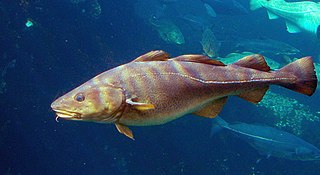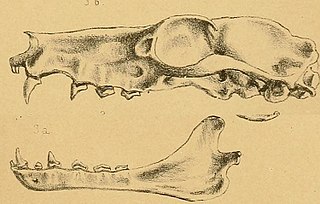
Cod is the common name for the demersal fish genus Gadus, belonging to the family Gadidae. Cod is also used as part of the common name for a number of other fish species, and one species that belongs to genus Gadus is commonly not called cod.

The sperm whale or cachalot is the largest of the toothed whales and the largest toothed predator. It is the only living member of the genus Physeter and one of three extant species in the sperm whale family, along with the pygmy sperm whale and dwarf sperm whale of the genus Kogia.

Gadus is a genus of demersal fish in the family Gadidae, commonly known as cod, although there are additional cod species in other genera. The best known member of the genus is the Atlantic cod.

Ancistrocheirus lesueurii, the sharpear enope squid, is the only species in the genus Ancistrocheirus and family Ancistrocheiridae. With a mantle length of 25 cm, this moderately sized squid may be found throughout the tropical and subtropical oceans. They tend to be found at mesopelagic depths.

The large-headed capuchin is a subspecies of the tufted capuchin monkey from South America. It is found in Bolivia, Brazil, Colombia, Ecuador and Peru. It was formerly thought to be its own species, but studies have found it to be a subspecies of the tufted capuchin.

Taningia danae, the Dana octopus squid, is a species of squid in the family Octopoteuthidae. It is one of the largest known squid species, reaching a mantle length of 1.7 m (5.6 ft) and total length of 2.3 m (7.5 ft). The largest known specimen, a mature female, weighed 161.4 kg (356 lb).

The Luzon fanged frog is a species of frog in the family Dicroglossidae. It is endemic to the Philippines.

Tachyoryctes is a genus of rodent in the family Spalacidae. It contains the following species:

The big-headed African mole rat,, also known as the giant root-rat, Ethiopian African mole rat, or giant mole rat, is a rodent species in the family Spalacidae. It is endemic to Ethiopia's Bale Mountains. Its natural habitat is subtropical or tropical high-altitude grassland, where it can reach densities of up to 2,600 individuals per square kilometre. It is threatened by habitat loss. Where the two species overlap, it is the main prey of the endangered Ethiopian wolf.

The Angolan epauletted fruit bat is a species of megabat in the family Pteropodidae. It is found in Angola and Namibia. Its natural habitats are dry savanna and moist savanna. It is threatened by habitat loss.
Mormyrus macrocephalus is a species of ray-finned fish in the family Mormyridae.
Haplochromis macrocephalus is a species of cichlid endemic to the Tanzanian portion of Lake Victoria where it is found in Mwanza Gulf and Speke Gulf. This species can reach a length of 10.6 centimetres (4.2 in) SL.

Atopochilus macrocephalus is a species of upside-down catfish endemic to Angola where it occurs in the Kwango River in the vicinity of Fort Don Carlos. This species grows to a length of 7.5 centimetres (3.0 in) SL. It is consumed for food and is threatened by human activities with very extensive diamond mining being the most significant threat.

Millerigobius macrocephalus is a species of goby native to coastal waters of the Adriatic Sea, the Levant Sea, the western Mediterranean and the Aegean Sea where it occurs in lagoons and shallow inshore waters to about 4 metres (13 ft) in depth with stones to provide shelter. This species can reach a length of 4.3 centimetres (1.7 in) SL. It is currently the only known member of its genus.

The Caspian tadpole goby is a species of goby which is widespread in the basin of the Caspian Sea, specifically in the near-estuary zone of the rivers and in small bays. It is a common species in the Volga River delta near Astrakhan, occurred in the deltas of rivers Terek, Ural, Samur. During the warmer months, this species prefers to live at depths of from .5 to 10 metres, moving in the colder months to depths of 20 to 25 metres. It can reach a length of 11.6 centimetres (4.6 in) TL.
Dialommus is a genus of labrisomid blennies native to the eastern Pacific Ocean.
Dialommus fuscus, the Galápagos four-eyed blenny, is a species of labrisomid blenny endemic to the coasts of the Galapagos Islands. It inhabits the intertidal zone where it lives in tide pools as well as traveling on land. Special adaptations of the corneas of the eye and the gill filaments allow this species to travel up to 30 metres (98 ft) from the ocean in search of prey items such as insects and shore-dwelling crabs.
Luciobrama macrocephalus, the long spiky-head carp, is a species of cyprinid fish that is found in China and Vietnam. It is the only member of its genus, and is classified as data deficient by the IUCN. It is found in rivers and lakes. Larger fish, over 30 centimetres (12 in) live nearer the bottom and the smaller specimens are found higher in the water column. They are partially migratory. It has not been recorded from its spawning sites since 1988.













